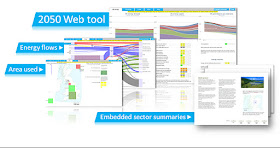In December 2011, DECC published the Carbon Plan and version 3 of the 2050 Pathways Calculator. As before, this open-source engineering-based tool is intended to support grown-up conversations about our possible energy futures. The user can choose any combination of demand-side and supply-side actions over the period to 2050, and the calculator computes and displays various consequences - energy flows, areas of land use, greenhouse gas emissions, and some security-of-supply indicators. The significant new feature in version 3 is the inclusion of costs, for the first time. Version 3 of the calculator also includes an air-quality calculator, which, like the costs calculator, is under development. Expert feedback is welcome.
Future costs are uncertain, and there are a range of views of the future costs of key technologies such as building insulation, low-carbon vehicles, nuclear power, wind power, carbon capture and storage, heat pumps, and energy storage technologies, and key fuels such as oil, gas, and energy crops. These ranges are reflected in the calculator's cost sensitivity visualizer by allowing the user to change the costs from the default values to higher or lower values, consistent with the ranges that DECC has found in the expert literature. The user can also visualize the consequences of cost uncertainty by selecting the Uncertain choice for any of the costed items. The calculator then shows the range of possible costs for the user's chosen pathway.
All the cost ranges, and the original sources, are explicitly detailed in an open wiki, to which experts are encouraged to contribute updated data. You can click through to the relevant bit of the wiki from any row of the cost-sensitivity page of the calculator. The wiki contains superb interactive visualizations of the cost ranges from the literature. Here's the Offshore Wind Costs Data visualization, for example. In the 2050 Calculator, you can compare the costs of your chosen pathway with other pathways, for example a handful that DECC has published, or those of experts. In the "Costs compared" view, you can compare all the pathways' costs simultaneously. In the "Cost sensitivity" view, you can compare your pathway in detail with one other comparator, which you can choose. In the web version of the calculator, costs are expressed in pounds per person per year. These are whole-energy-system costs, not people's home energy bills. For example, the costs of vehicles, building retrofit, and industrial infrastructure are included. Don't forget, the cost difference between two pathways depends on the cost assumptions. You can use the default cost assumptions if you want, but you can be sure that those costs won't turn out to be exactly right! So I encourage users to use the cost-sensitivity feature; taking into account the cost uncertainties will give you a more reasonable picture of future possible cost ranges, and ranges of cost differences.
For me, one key message from this tool is the importance of innovation support to bring down the costs of all the technologies that may be important in the future.
Media coverage - The Carbon Plan and the 2050 Calculator have had a little bit of media coverage in the last month, including a nice mention in an editorial in Nature magazine.
Some of the coverage has been so inaccurate, however, that one is forced to conjecture that the authors of two recent pieces in the Telegraph made little effort to check their facts. For example, Christopher Booker perpetuates the twaddle of a blogger who invented the assertion that the 2050 calculator 'had been designed on the assumption that, with wind power, Britain would require much less energy, because we would have become more “energy efficient”, by insulating our homes and so forth'. This is complete twaddle, as anyone who takes the time to actually look at the open-source calculator can confirm. The user is perfectly free to combine any choice of energy-efficiency measures with any choice of energy-supply mix. Yes, the government's published pathways combine "green" energy sources (eg nuclear and wind) with energy-efficiency choices. But the calculator does not 'assume' or 'force' this choice. You can easily make high-fossil-fuel pathways with strong energy-efficiency action, if you want. It's all up to you, as the user. I think it's an awesome piece of "open-source policy development", and I'd like to congratulate the civil servants who did it, and thank all the hundreds of experts and volunteers who have helped them in their work. I really hope this open, factual tool can now be constructively used by politicians and opinion-formers to help public engagement with the issues of long-term energy security and climate-change action.


This looks very interesting. I will definitely look into in depth next week when I have time to absorb the information :)
ReplyDelete